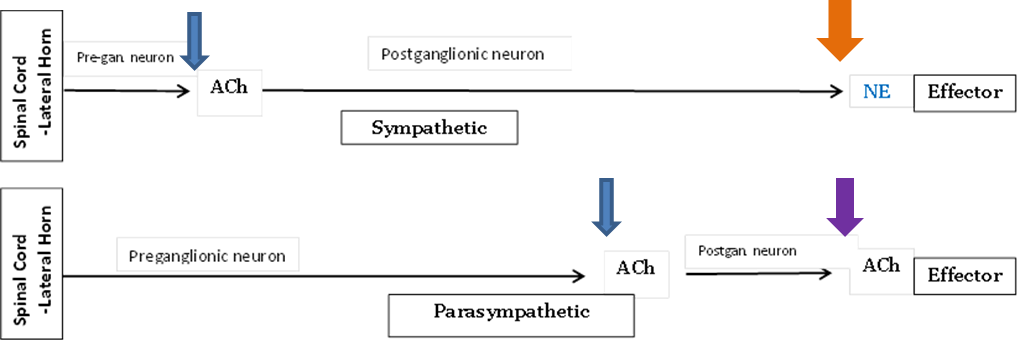Motor Output for the ANS to Smooth/Cardiac Muscles and Glands
As we have previously stated: an axon from the neuron originating from the CNS that projects to a sympathetic ganglion is referred to as a preganglionic fiber or neuron, and represents the output from the CNS to the ganglion. Because the sympathetic ganglia are adjacent to the vertebral column, preganglionic sympathetic fibers are relatively short, and they are myelinated. The preganglionic fiber passes the signal across the synapse in the autonomic ganglion by releasing the ACh. The neurotransmitter diffuses across the synaptic cleft and binds to nicotinic ACh receptors on the postganglionic fiber, thus stimulating the neuron. Nicotinic receptors are lings gated channels that open in the presence of ACh allowing sodium to enter the postganglionic fiber and cause an action potential. The postganglionic fiber or neuron —the axon from a ganglionic neuron that projects to the target effector—represents the output of a ganglion that directly influences the organ. Compared with the preganglionic fiber, postganglionic sympathetic fibers are long because of the relatively greater distance from the ganglion to the target effector. These fibers are unmyelinated. The postganglionic fiber passes the signal across the synapse to the effectors by releasing the NE. The neurotransmitter diffuses across the synaptic cleft and binds to variations of alpha (α) and beta (β) receptors on the effector, thus causing systemic change. Because NE is the neurotransmitter used at the effector, the overall response of this system is termed adrenergic. (ADRENaline = ADRENergic).

Figure 6: In this figure of the ANS pathways, thinner blue arrows show where nicotinic receptors receive acetylcholine (ACh) at the postganglionic neuron, the orange arrow shows where adrenergic alpha and beta receptors receive Norepinephrine (NE) along the sympathetic pathway. The purple arrow shows where muscarinic receptors receive the ACh at the effector.
The sympathetic output of the nervous system originates out of the lateral horn of the thoracolumbar spinal cord. An axon from one of these central neurons projects by way of the ventral spinal nerve root and spinal nerve to a sympathetic ganglion, either in the sympathetic chain ganglia or one of the collateral locations, where it synapses on a ganglionic neuron. These preganglionic fibers release ACh, which excites the ganglionic neuron through the nicotinic receptor. The axon from the ganglionic neuron—the postganglionic fiber—then projects to a target effector where it will release norepinephrine to bind to an adrenergic receptor, causing a change in the physiology of that organ in keeping with the broad, divergent sympathetic response. The postganglionic connections to sweat glands in the skin and blood vessels supplying skeletal muscle are, however, exceptions; those fibers release ACh onto muscarinic receptors. The sympathetic system has a specialized preganglionic connection to the adrenal medulla that causes epinephrine and norepinephrine to be released into the bloodstream rather than exciting a neuron that contacts an organ directly. This hormonal component means that the sympathetic chemical signal can spread throughout the body very quickly and affect many organ systems at once.
This also means that it takes longer for this effect to leave the body, too. Think about when you've been angry, and once you realize that you shouldn't be angry anymore it still takes a while to calm back down. This is for several reasons. One, the epinephrine and norepinephrine (NE) are delivered through the bloodstream, so will be in contact with cells for a longer period of time. Two, the NE remains in the synaptic cleft longer than ACh does, because it takes longer to break it down (by the NE by MAOs vs the ACh-E and ACh, which is much quicker). A third reason is that the NE is more widespread from the Sympathetic (SANS) division, whereas the Parasympathetic (PANS) division has ganglia in the target organs or close by, so ACh is less widespread. So, just like anger, the sympathetic division takes longer for the neurotransmitters to reduce their effects on the body's organs than does the parasympathetic division.